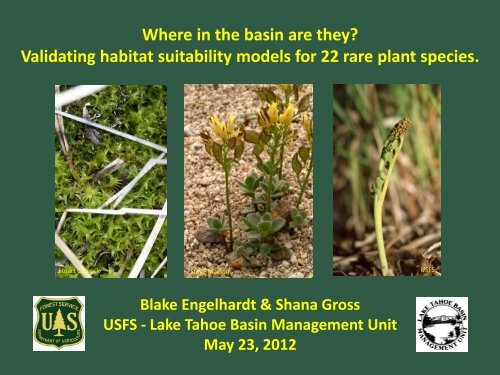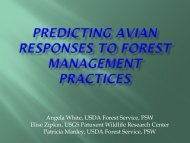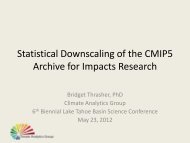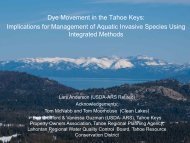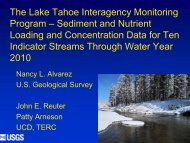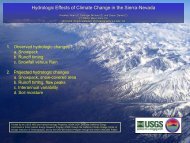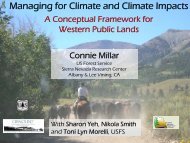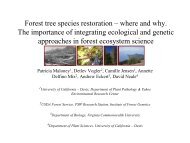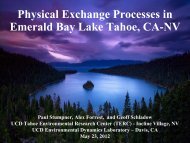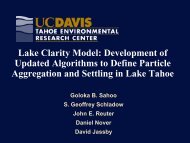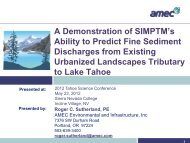Engelhardt, Blake
Engelhardt, Blake
Engelhardt, Blake
You also want an ePaper? Increase the reach of your titles
YUMPU automatically turns print PDFs into web optimized ePapers that Google loves.
Where in the basin are they?<br />
Validating habitat suitability models for 22 rare plant species.<br />
Stuart Osbrack<br />
Steve Matson<br />
USFS<br />
<strong>Blake</strong> <strong>Engelhardt</strong> & Shana Gross<br />
USFS - Lake Tahoe Basin Management Unit<br />
May 23, 2012
Background<br />
National forests are tasked with:<br />
1) maintaining viable populations of TES species<br />
2) preventing degradation of suitable habitat<br />
What constitutes suitable habitat?<br />
How much of it occurs on the landscape and where is it?<br />
LTBMU<br />
25 sensitive botanical species<br />
(19 vascular plants, 4 bryophytes, 1 lichen, 1 fungi)<br />
2 candidate species: Rorippa subumbellata (Tahoe Yellowcress)<br />
Pinus albicaulis (Whitebark Pine)*<br />
*Warranted but precluded from listing under ESA, July 2011
Binary GIS Models<br />
• Species distribution predicted from environmental variables<br />
• Classify landscape: suitable vs. non-suitable<br />
• Model Builder: Boolean AND/OR analysis of various<br />
environmental data (GIS layers) to determine suitable<br />
habitat<br />
Products<br />
• Total area of suitable habitat<br />
• Spatial pattern/location of<br />
suitable habitat
-15 habitat models, cover 22 species total<br />
-known or likely to occur in Lake Tahoe basin<br />
Wet/Riparian<br />
Botrychium spp.<br />
Bruchia bolanderi*<br />
Epilobium howellii<br />
Meesia spp./Helodium blandowii<br />
Peltigera hydrothyria*<br />
USFS<br />
Upland/Forested<br />
Arabis rectissima v. simulans<br />
Arabis rigidissima v. demota<br />
Arabis tiehmii*<br />
J. Morefield<br />
Eriogonum umbellatum v. torreyanum*<br />
Hulsea brevifolia*<br />
Lewisia kelloggii*<br />
Alpine<br />
Draba asterophora v. asterophora<br />
Draba asterophora v. macrocarpa<br />
Draba-Union<br />
Lewisia longipetala<br />
USFS
Example: Lewisia longipetala<br />
General Criteria GIS Dataset Refined Criteria (AND)<br />
Northerly Aspect Aspect 0-90°, 270-360°<br />
High Elevation Elevation >8300 ft<br />
Subalpine & Alpine<br />
Communities<br />
Potential Natural<br />
Vegetation<br />
TSME, TSME-ABMA, Rocky,<br />
Scree-subalpine/alpine<br />
Granitic soils Geology Igneous intrusive, and<br />
extrusive, sedimentary
Botrychium spp.<br />
(Moonwort complex)<br />
Peltigera hydrotheria<br />
(Veined Water Lichen)<br />
Draba asterophora v. asterophora<br />
(Tahoe Draba)<br />
Lewisia kelloggii<br />
(Kellogg’s Lewisia)
ARRE<br />
ARRID<br />
ARTI<br />
BOTRY<br />
BRBO<br />
DRABA UNION<br />
DRASA<br />
DRASM<br />
EPHO<br />
ERUMT<br />
HUBR<br />
LEKE<br />
LELO<br />
MEESIA_HEBL<br />
PEHY<br />
Lake Tahoe Basin<br />
(hectares)<br />
Predicted Area of Suitable Habitat w/in Lake Tahoe Basin<br />
90000<br />
80000<br />
70000<br />
60000<br />
50000<br />
40000<br />
30000<br />
20000<br />
10000<br />
0<br />
(1 hectare = ~2.5 acres)
Field Validation<br />
• 500m x 500m grid<br />
• 100 randomly selected points<br />
• 15 excluded (private property)<br />
• 85 total points<br />
• Field visit: presence/absence<br />
of suitable habitat & species<br />
• 45 of 85 completed<br />
2009- 9 points<br />
2010- 4 points<br />
2011- 32 points<br />
2012- 40 points planned… any volunteers?!
45 Visited Points:<br />
Few points on North Shore<br />
All elevations<br />
All species
40 Remaining Points:<br />
Throughout the basin<br />
All elevations<br />
All species
Preliminary results:<br />
- 7 of 15 models had >90% accuracy<br />
- mostly over-prediction<br />
- all upland and alpine species<br />
Species<br />
% Sites<br />
Habitat<br />
Predicted<br />
% Model<br />
Agreement<br />
% Overpredict<br />
% Underpredict<br />
Habitat<br />
Arabis tiehmii 2.2 100 0 0 Upland<br />
Draba-Union 3.1 97 0 3 Alpine<br />
Draba asterophora v.<br />
macrocarpa<br />
Draba asterophora v.<br />
asterophora<br />
13.3 96 4 0 Alpine<br />
15.6 93 7 0 Alpine<br />
Lewisia longipetala 15.6 93 7 0 Alpine<br />
Arabis rigidissima v.<br />
demota<br />
Eriogonum umbellatum<br />
v. torreyanum<br />
57.8 91 9 0 Upland<br />
11.1 91 7 2 Upland
Preliminary results:<br />
- 4 of 15 models had 80-89% accuracy<br />
- all over-predict, some under-prediction<br />
- riparian and upland species<br />
Species<br />
% Sites<br />
Habitat<br />
Predicted<br />
% Model<br />
Agreement<br />
% Overpredict<br />
% Underpredict<br />
Habitat<br />
Botrychium spp. 86.7 89 11 0 Wet/Riparian<br />
Arabis rectissima v.<br />
simulans<br />
28.9 82 9 9 Upland<br />
Bruchia bolanderi 84.4 82 16 2 Wet/Riparian<br />
Hulsea brevifolia 62.2 80 20 0 Upland
Preliminary results:<br />
- 4 of 15 models had low (67-71%) accuracy<br />
- most over-predict AND under-predict<br />
- mostly riparian species<br />
- missing some mesic habitats<br />
Species<br />
Peltigera<br />
hydrothyria<br />
% Sites<br />
Habitat<br />
Predicted<br />
% Model<br />
Agreement<br />
% Overpredict<br />
% Underpredict<br />
Habitat<br />
57.8 71 20 9 Wet/Riparian<br />
Lewisia kelloggii 73.3 69 29 2 Upland<br />
Epilobium howellii 48.9 67 4 29 Wet/Riparian<br />
Meesia spp. &<br />
Helodium blandowii<br />
46.7 67 16 18 Wet/Riparian
What’s working…<br />
• Elevation, aspect, slope, high<br />
elevation forests<br />
(Draba, Lewisia)<br />
• Conifer/forest types- generalists<br />
(Arabis, Eriogonum)<br />
• Larger areas of meadow and riparian<br />
habitat<br />
D. Taylor
Scale<br />
• understory layers, ground cover (e.g. thick<br />
duff or bare ground)<br />
• vegetation layer- small patches of riparian<br />
vegetation, wet meadow, wet habitats<br />
• forest openings, canopy cover<br />
USFS<br />
USFS<br />
Other Challenges<br />
• substrate within perennial streams, dry<br />
gullies predicted as perennial streams<br />
• species not known from LTBMU- less<br />
information on suitable habitat<br />
• geologic restrictions
Detection of 8 new occurrences of 3 sensitive species:<br />
1. Botrychium crenulatum (BOCR2, BOCR3)<br />
(South Lake Tahoe & Zephyr Cove)<br />
2. Draba asterophora v. asterophora (DRASA 1p, 2n, 2o)<br />
(Job’s Sister & Heavenly Ski Area)<br />
3. Lewisia longipetala (LELO 4a, 4b, 4c)<br />
(Jack’s Peak)<br />
USFS<br />
USFS
Future Steps<br />
• Equal effort: under-prediction vs. over-prediction<br />
K. Morse<br />
• Functionality of the model vs. true suitable habitat<br />
detection<br />
• Goal: 80% accuracy<br />
• Pinus albicaulis: use TEUI layer? Existing Veg Map?<br />
Remaining points?<br />
• LIDAR & multispectral imagery? Maybe for trees<br />
but not herbaceous species<br />
K. Morse
Thanks to: Kurt Teuber, Kyle Christie, Cristina McKernan, Dionne Uzes,<br />
Sean Glantz, Diku Sherpa, Katie Heard, Mike Jennings<br />
USFS


